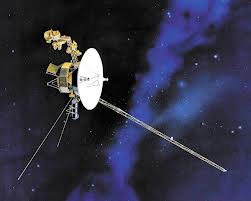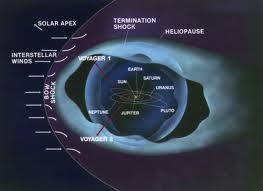 Some 35 years after leaving the Earth, and 11 billion miles of travel, the Voyager 1 spacecraft has reached what scientists believe is the final new region of deep space to be encountered before the spacecraft enters interstellar space. Launched in 1977, 16 days ahead of its twin the Voyager 2 spacecraft, Voyager 1 is the most distant human-made object in the universe.
Some 35 years after leaving the Earth, and 11 billion miles of travel, the Voyager 1 spacecraft has reached what scientists believe is the final new region of deep space to be encountered before the spacecraft enters interstellar space. Launched in 1977, 16 days ahead of its twin the Voyager 2 spacecraft, Voyager 1 is the most distant human-made object in the universe.
The new region of deep space is referred to by NASA scientists as a magnetic highway for charged particles because our sun’s magnetic field lines are connected to interstellar magnetic field lines. According to NASA, the connection allows lower-energy charged particles that originate from inside the bubble of charged particles the sun blows around itself, known as the heliosphere, to zoom out and allows higher-energy particles from outside to stream in.
 At the American Geophysical Union meeting in San Francisco on Monday, the Voyager team reported that they consider the current region of Voyager 1 to still be “inside our solar bubble” because the direction of the magnetic field lines has not changed, as they expect will happen when Voyager breaks through to interstellar space.
At the American Geophysical Union meeting in San Francisco on Monday, the Voyager team reported that they consider the current region of Voyager 1 to still be “inside our solar bubble” because the direction of the magnetic field lines has not changed, as they expect will happen when Voyager breaks through to interstellar space.
“Although Voyager 1 still is inside the sun’s environment, we now can taste what it’s like on the outside because the particles are zipping in and out on this magnetic highway,” said Edward Stone, Voyager project scientist based at the California Institute of Technology, Pasadena. “We believe this is the last leg of our journey to interstellar space. Our best guess is it’s likely just a few months to a couple years away. The new region isn’t what we expected, but we’ve come to expect the unexpected from Voyager.”
Eight years ago in December 2004, Voyager 1 crossed a point in space called the termination shock. Since that time, spacecraft has been exploring the heliosphere’s outer layer, known as the heliosheath. Here, the solar wind abruptly slowed down from supersonic speeds and became turbulent. A little over two years ago, the spacecraft detected that the outward speed of the solar wind slowed to zero. At the same time, the intensity of the magnetic field also began to increase.
According to the spacecraft data, which takes about 17 hours to beam back to the Earth, Voyager 1 reached its current region of the “magnetic highway” during the summer of 2012.
“We are in a magnetic region unlike any we’ve been in before — about 10 times more intense than before the termination shock — but the magnetic field data show no indication we’re in interstellar space,” said Leonard Burlaga, a Voyager magnetometer team member based at NASA’s Goddard Space Flight Center in Greenbelt, Md. “The magnetic field data turned out to be the key to pinpointing when we crossed the termination shock. And we expect these data will tell us when we first reach interstellar space.”
To follow the progress of Voyager 1 and Voyager 2, go online to NASA’s dedicated web site for the Jet Propulsion Laboratory managed mission at: http://www.nasa.gov/voyager.
![Herbal Reference Substances are Key to Everyday Products <!-- AddThis Sharing Buttons above -->
<div class="addthis_toolbox addthis_default_style " addthis:url='http://newstaar.com/herbal-reference-substances-are-key-to-everyday-products/3512112/' >
<a class="addthis_button_facebook_like" fb:like:layout="button_count"></a>
<a class="addthis_button_tweet"></a>
<a class="addthis_button_pinterest_pinit"></a>
<a class="addthis_counter addthis_pill_style"></a>
</div>When it comes to quality control testing and the development of new products, Botanical Reference Materials (BRMs), also known as Herbal References are critically important. To help companies ultimately obtain all-important FDA approval, the Food and Drug Administration provides in its guidance a recommendation that […]<!-- AddThis Sharing Buttons below -->
<div class="addthis_toolbox addthis_default_style addthis_32x32_style" addthis:url='http://newstaar.com/herbal-reference-substances-are-key-to-everyday-products/3512112/' >
<a class="addthis_button_preferred_1"></a>
<a class="addthis_button_preferred_2"></a>
<a class="addthis_button_preferred_3"></a>
<a class="addthis_button_preferred_4"></a>
<a class="addthis_button_compact"></a>
<a class="addthis_counter addthis_bubble_style"></a>
</div>](http://newstaar.com/wp-content/uploads/2021/02/Achillea_millefolium_flowers-100x100.jpg)
![Quality Electrochemical Biosensors are Critical for Medical, Food and Chemical Industry <!-- AddThis Sharing Buttons above -->
<div class="addthis_toolbox addthis_default_style " addthis:url='http://newstaar.com/quality-electrochemical-biosensors-are-critical-for-medical-food-and-chemical-industry/3512086/' >
<a class="addthis_button_facebook_like" fb:like:layout="button_count"></a>
<a class="addthis_button_tweet"></a>
<a class="addthis_button_pinterest_pinit"></a>
<a class="addthis_counter addthis_pill_style"></a>
</div>A number of industries have, at their core, a need to frequent or even continuous analysis of biological media. These include the medical and pharmaceutical fields, biotech firms, and food and chemical companies. To maintain quality standards and develop new products, these industries rely heavily […]<!-- AddThis Sharing Buttons below -->
<div class="addthis_toolbox addthis_default_style addthis_32x32_style" addthis:url='http://newstaar.com/quality-electrochemical-biosensors-are-critical-for-medical-food-and-chemical-industry/3512086/' >
<a class="addthis_button_preferred_1"></a>
<a class="addthis_button_preferred_2"></a>
<a class="addthis_button_preferred_3"></a>
<a class="addthis_button_preferred_4"></a>
<a class="addthis_button_compact"></a>
<a class="addthis_counter addthis_bubble_style"></a>
</div>](http://newstaar.com/wp-content/uploads/2020/10/Electrochemical-Biosensor-100x100.jpg)
![Company Develops Industrial Mixers Well-Suited for both Fragile and Explosive Products <!-- AddThis Sharing Buttons above -->
<div class="addthis_toolbox addthis_default_style " addthis:url='http://newstaar.com/company-develops-industrial-mixers-well-suited-for-both-fragile-and-explosive-products/3512071/' >
<a class="addthis_button_facebook_like" fb:like:layout="button_count"></a>
<a class="addthis_button_tweet"></a>
<a class="addthis_button_pinterest_pinit"></a>
<a class="addthis_counter addthis_pill_style"></a>
</div>Industrial drum mixers are normally applied to blend mixes of varying viscosities such as adhesive slurries or cement. Some of these mixers have the capability of blending mixes of very different particle sizes such as fruit and ice cream, and gravel and cement slurry. The […]<!-- AddThis Sharing Buttons below -->
<div class="addthis_toolbox addthis_default_style addthis_32x32_style" addthis:url='http://newstaar.com/company-develops-industrial-mixers-well-suited-for-both-fragile-and-explosive-products/3512071/' >
<a class="addthis_button_preferred_1"></a>
<a class="addthis_button_preferred_2"></a>
<a class="addthis_button_preferred_3"></a>
<a class="addthis_button_preferred_4"></a>
<a class="addthis_button_compact"></a>
<a class="addthis_counter addthis_bubble_style"></a>
</div>](http://newstaar.com/wp-content/uploads/2020/06/bandeau-sofragir2-100x100.jpg)